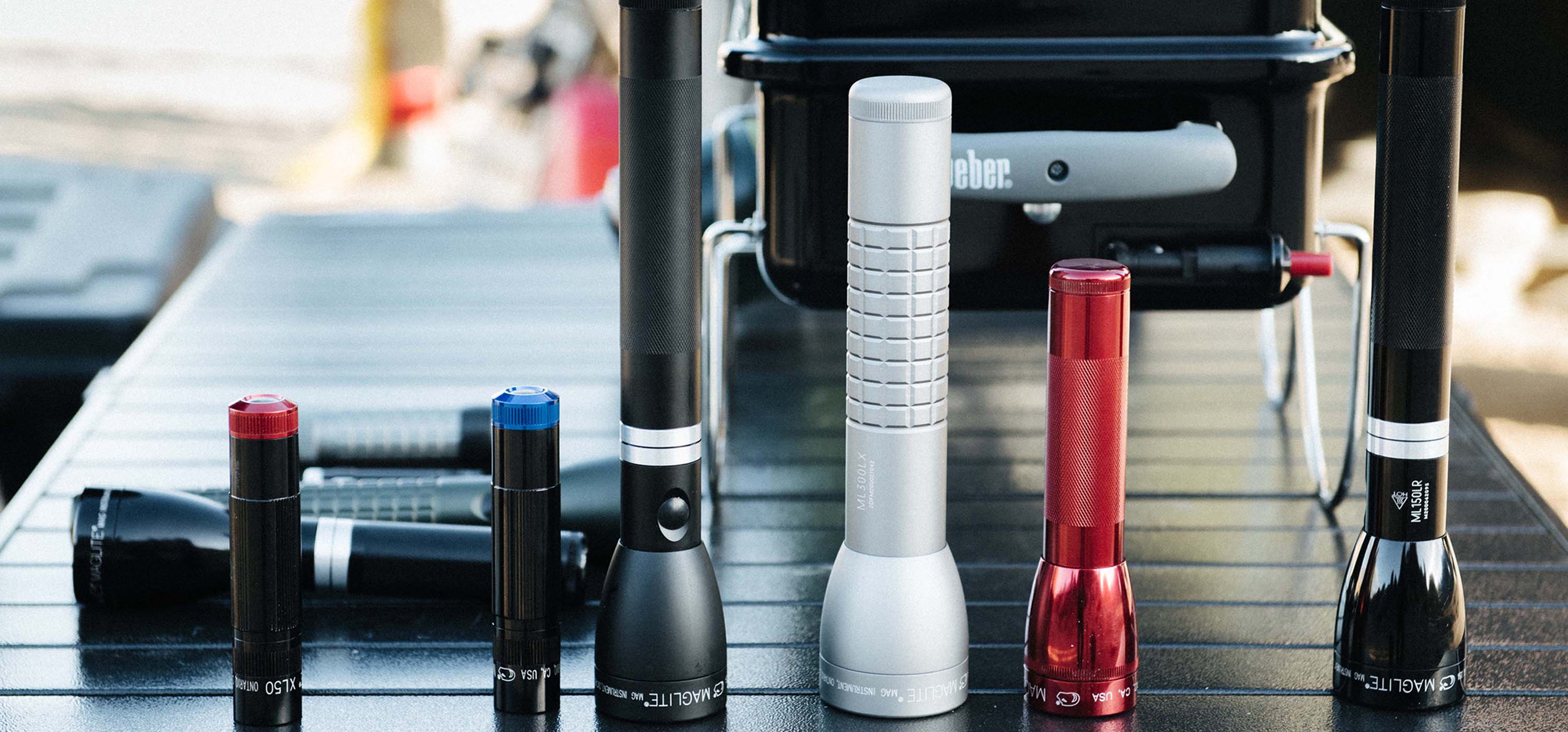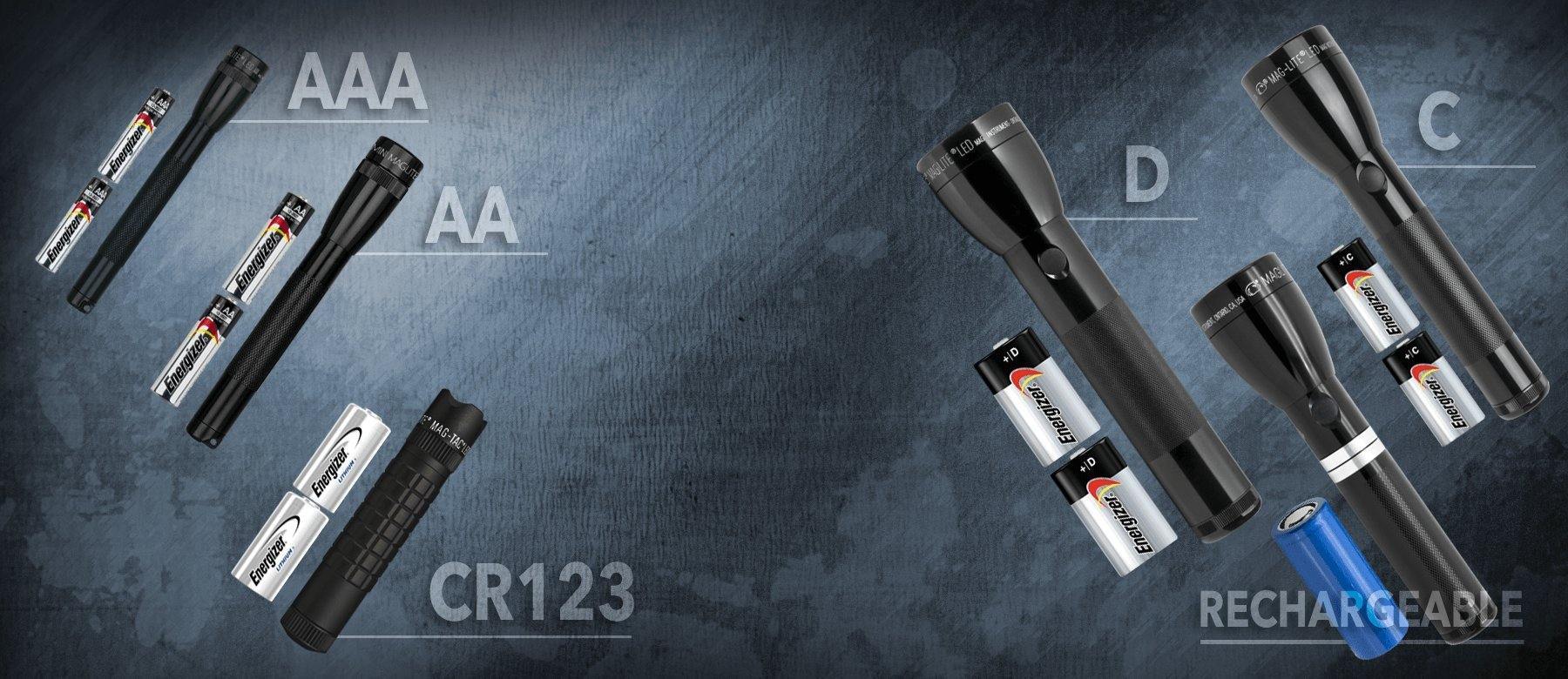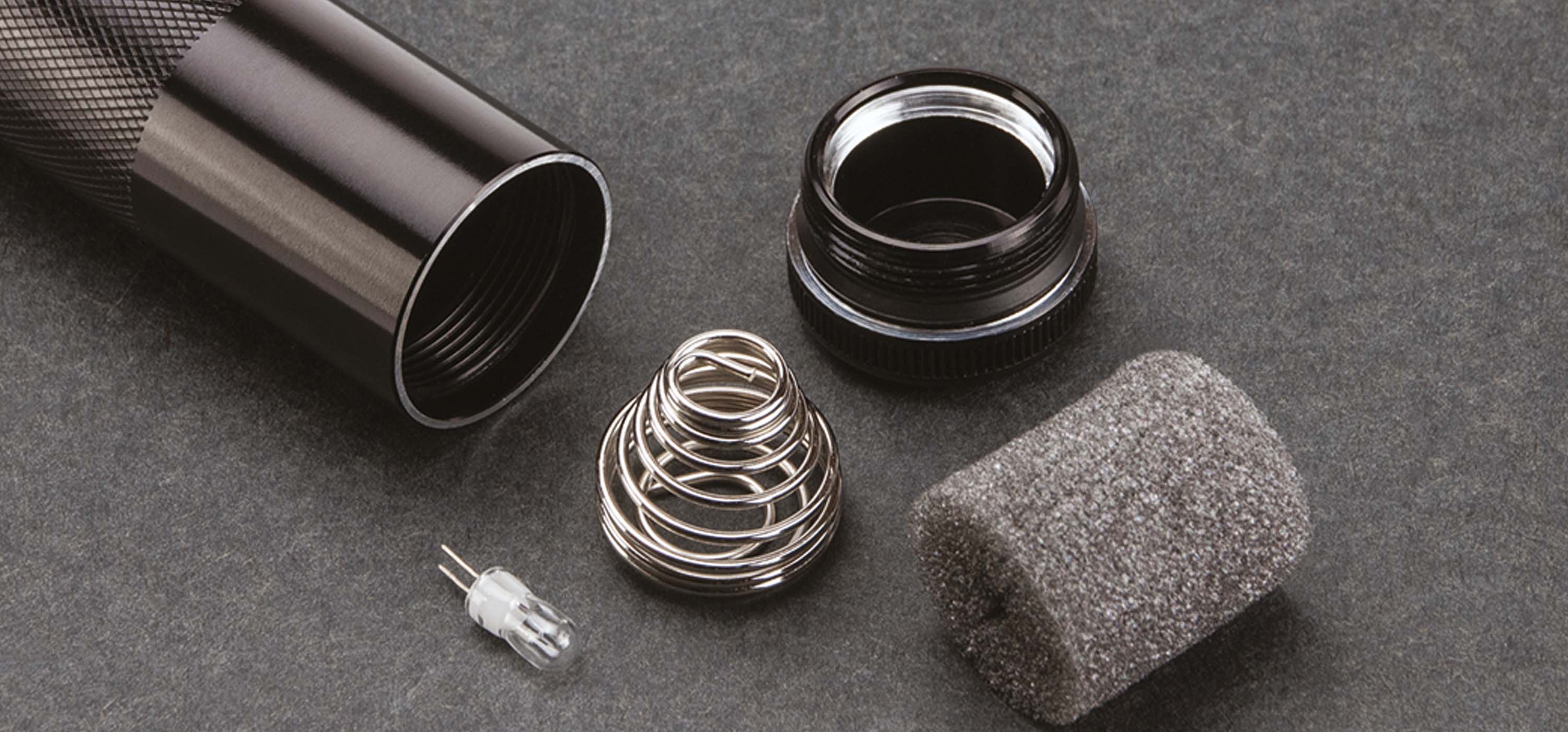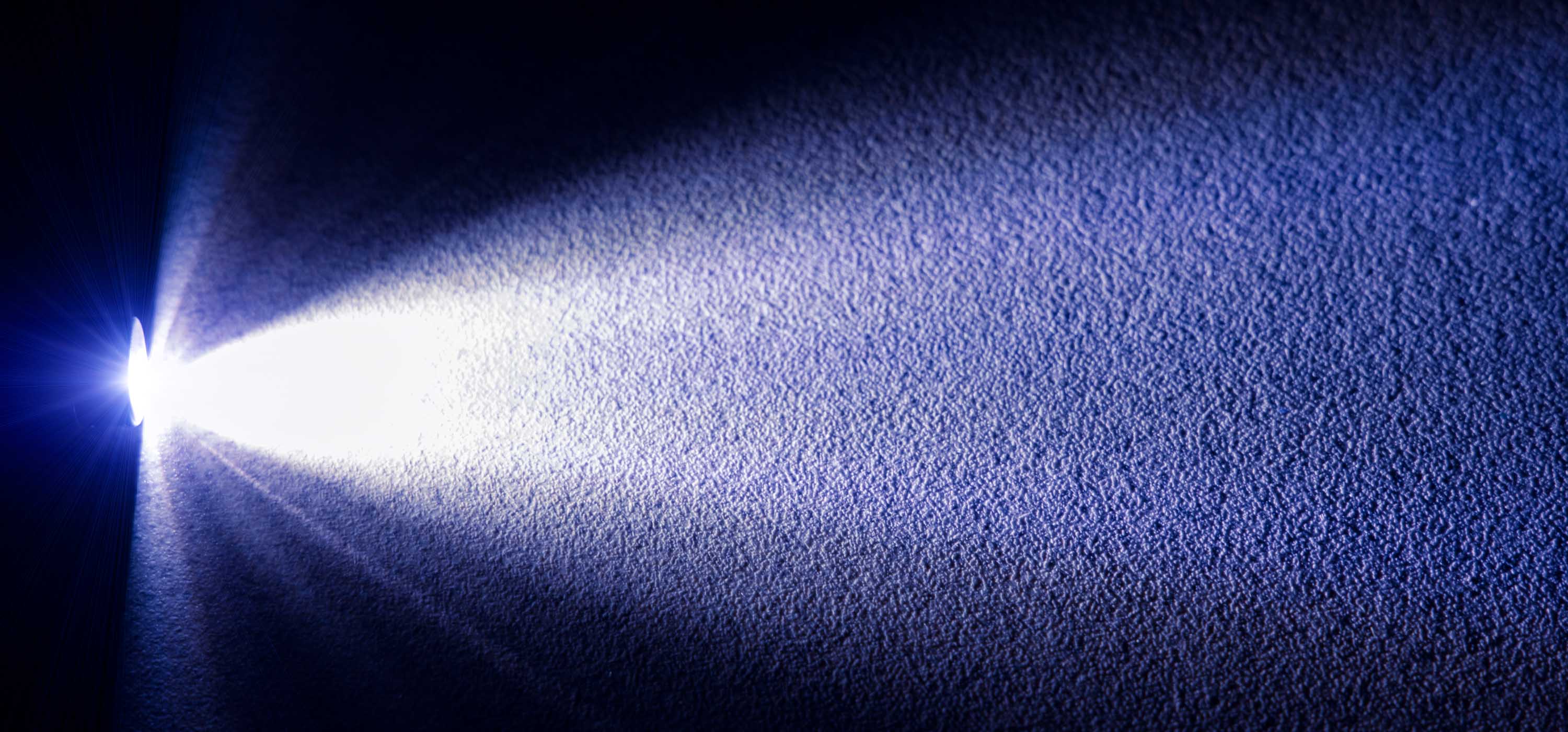General
MAGLITE® does not offer LED units, “upgrade or conversion kits”. The reason is that the design of a light bulb flashlight is different from that of an LED flashlight. We strongly advise against such third-party components that are not authorized and confirmed by Maglite®. If a third-party component is installed, any guarantee/warranty will be void. Depending on the intended use, we therefore recommend using a light bulb or an LED flashlight. Both have their place.
We consider our Maglite® flashlights to be extremely water resistant, but we do not advertise them as waterproof.
It sounds like you may be using the wrong replacement bulb for your flashlight. D- and C-cell Maglite® flashlights have different numbers of batteries or cells and therefore operate at different voltages. Therefore, each Maglite® flashlight requires its own lamp size. For example, if you have a 4-cell Maglite® flashlight and you put a 2-cell or 3-cell lamp in it, it will burn out very quickly because the 4-cell flashlight runs on a higher voltage than the lamp on a 2- or 3-cell flashlight. Cells flashlight. For our flashlights, a 2-cell AA Mini-Maglite, a 2-cell AAA Mini-Maglite and a 1-cell AAA Solitaire® flashlight, each required its own lamp. If you use the 1xAAA Solitaire® bulb in a 2x AA or 2-AAA lamp, the lamp will burn out immediately. Make sure you buy the right bulb for your flashlight. It is noted on the packaging of our replacement lamps. If you are not sure which lamp to use in your flashlight, do not hesitate to contact us via our contact form to reach.
Maglite® flashlights are general purpose flashlights. We have not tested or certified them for specific purposes to any “safe” standard or to any of the various “explosion-proof” standards that exist. We do not label our flashlights as “explosion proof” and do not guarantee that they will be safe for such specialized use.
If you cannot remove the end cap to change the batteries, it is likely that the batteries have leaked and caused internal corrosion. Maglite® does not guarantee battery leakage. If the flashlight has been damaged by leaking batteries, do not return the flashlight to Maglite®, but rather determine which brand of battery caused the damage and follow the battery manufacturer's instructions for making a claim.
The LED of a Maglite® flashlight is a permanent component and not a "perishable" or "consumable" item like a battery or incandescent bulb (either a vacuum or gas-filled xenon or halogen lamp, depending on the product selected). Under normal use, the LED should last a lifetime and never need to be replaced.
The explanation of these statements is a bit complicated. It begins by answering a preliminary question: "How do you define when the useful life of an LED is over?" For an incandescent lamp (either a vacuum or a gas-filled xenon or halogen lamp, depending on the product chosen) (incandescent lamp), this question is It's so simple that no one ever asks it: the lifespan of a light bulb is over when it burns out. The “burnout” of a light bulb is a sudden, catastrophic, total failure. It's unmistakable when it happens. "Burnout" occurs when the lamp's filament (usually made of tungsten, a very high-melting but brittle metal) becomes so thin and weak that it can no longer support its weight, especially when subjected to shock. So the filament breaks. When this occurs, the flashlight cannot complete the circuit that normally flows through the filament. So when you turn on the flashlight, it doesn't emit any light. When we say a light bulb is “dead,” we mean that its filament has suddenly and catastrophically failed.
But if we ask the same question about an LED: “How do you define when the useful life of an LED has come to an end?” – The answer isn't nearly as simple, since an LED doesn't typically fail suddenly and catastrophically: there is no filament that "burns out," nor is there any other clear, unambiguous event that one can point to and say that the LED is dead. Instead, what typically happens with an LED is that its light output decreases extremely slowly and very gradually with use.
Much of the literature states that an LED should operate for 50,000 to 100,000 hours in a typical installation, before their light output drops to 50% of their original output. So if we define 50% as the end point of usage time and if a flashlight is used 1 hour per week (and even that could be a lot for a typical homeowner who uses the flashlight sporadically, occasionally and occasionally). (in short episodes), the “useful life” of the LED (as defined above) should be 50,000 to 100,000 weeks, i.e. between one and two thousand years. Even if the user is a night watchman whose flashlight is actually on 4 hours per night and 5 nights per week - which would be a lot - the "use life" of the LED (as defined above) should be between 1,666 and 3,333 weeks (i.e., between 48 and 96 years).
Also keep in mind that the definition of the “end point of life of an LED” as “50% of the initial light output” is arbitrary and one can argue that it is far too short: 50 % of original The luminous efficacy of a powerful LED flashlight is still very large, and it seems doubtful that a typical user would throw the flashlight away at this point (even if they lived long enough to reach that point). For comparison, the widely followed ANSI/NEMA FL-1 Flashlight Basic Performance Standard (2009), which dictates how to evaluate the “run time” of a flashlight with a new set of batteries, defines the end point of the “useful life” of batteries. This is the point at which the light output drops to 10% - not 50% - of the original output. Therefore, according to the committee that drafted the ANSI standard, 10%, rather than 50%, of the initial light output is the reasonable point at which one can say that the user would likely view the batteries as no longer serviceable and in need of replacement. If we were to define the end point for the "useful life" of an LED as 10% rather than 50% of the original light output, we might have to talk about a "useful life" of centuries rather than years. However, no one would claim that an LED is absolutely “bulletproof” under all conditions. It goes without saying that anyone who uses their LED flashlight as a striking tool or fire digger is looking for trouble. And if, for example, an LED were operated significantly above the intended nominal voltage and/or current, it could quickly fail. Even if an LED were operated slightly (but not greatly) above its rated voltage and/or current for an extended period of time, this could accelerate the decline in its light output. Operating temperatures that are too high can also endanger the lifespan of an LED. However, Maglite flashlights are carefully designed to maintain voltage and current within rated specifications when used with batteries of the correct voltage. Means of good, efficient heat dissipation are also built in to keep the operating temperature within the nominal limits.
In view of all this, the statement with which we began this discussion is quite reasonable: the LED of a Maglite® flashlight should be considered a permanent component, not a "perishable" or "consumable" item such as a battery or light bulb, and the user should assume that under normal use the LED will remain functional throughout its life and will never need to be replaced.
Flashlight Performance Testing - The ANSI Standard
In 2009, the American National Standards Institute, in collaboration with the National Electrical Manufacturers Association, published a standard called ANSI/NEMA FL 1-2009 Torch Basic Performance Standard. The ANSI standard has become widely accepted in the portable lighting industry because it provides a convenient way to make comparisons between different flashlights.
Although the ANSI standard is not mandatory, Maglite® has chosen to to follow him. For this reason, we display certain flashlight performance data on our product packaging, in our product literature and on the website in the form of an “ANSI strip,” so called because it uses the officially named ANSI logos and reports data collected on the in the manner prescribed by ANSI.
The ANSI standard defines four basic performance categories and requires official logos for displaying results. The following table lists the categories and indicates the unit of measurement, the official logo and the basic meaning of the category:
Light output in relation to the lighting range
According to the questions and comments Judging from what we get, the distinction between light output and lighting range causes some confusion. It's important to understand that these two concepts - light output and lighting range - are quite different characteristics that, surprisingly for many people, don't necessarily go hand in hand. A flashlight can have a very high light output (measured in lumens) and yet a very short beam range (measured in meters). And the opposite can also be true: a flashlight can have a very modest lumen output and still be remarkably effective at illuminating a very distant object.
Why is this possible? Because light output is simply a raw measure of the speed at which a light source produces light - i.e. H. how many photons, how much “luminous flux” the source produces per second. It says nothing about how well or poorly the light is collected and directed. Illumination range, on the other hand, is a measure of the maximum distance from which an optimally focused flashlight casts a useful amount of light onto a target. The ANSI standard effectively defines a “useful light level” by requiring that the beam distance be the maximum distance at which the flashlight produces ¼ lux of light. A quarter lux can be roughly described as the amount of light produced by a full moon in an open field on a clear night. That's not as bright as daytime, but it's bright enough to see - a good, standard, working definition of "useful light intensity."
So while the light output of a flashlight - its " Lumen Rating” – which says nothing at all about how well or poorly the flashlight produces a useful beam of light – the flashlight’s “beam distance” is entirely about its ability to produce a useful beam of light, converting light into a useful beam and directing it in a useful direction send. “Light range” therefore correlates strongly with the optical quality of a flashlight; whereas the light output has nothing at all to do with the beam shaping optics. In order to achieve high light output, a flashlight would not have to have a reflector or lens at all!
Optics are important!
Maglite® has been there from the start prides itself on its beam-forming optics – the quality of its precision-engineered reflectors and the versatility of its spot-to-flood beam focusing mechanism. High-quality optics help a flashlight direct light sensibly without using excessive power - something that is not possible with the "brute force" approach to maximizing lumen output.
Optics and runtime
High-quality optics can also help slow down battery consumption and extend runtime. As LED technology continues to advance, the number of watts consumed per lumen of light produced is decreasing. Still, the more lumens you want, the faster you'll use up battery power. Therefore, it is still true, and will likely always be true, that excellent beam-forming optics improve a flashlight's ability to provide useful light while avoiding the need for huge lumen output and correspondingly rapid battery drain.
Maglite® flashlights utilize patented heat sink technology to maximize LED performance and lifecycle. To achieve maximum performance and extend the life of your flashlight, it is important to establish a low thermal resistance path that allows heat to flow from the LED to the surrounding air. Maglite® manufactures its patented heat sink technology components locally in Ontario, California, USA.
Maglite Icon Glossary (link)
SPECTRUM SERIES™
- Spectrum Red LED: 620nm - 630nm
- Spectrum Green LED: 520nm - 535nm
- Spectrum Blue LED: 465nm - 485nm
- Spectrum Warm white LED: n.a.
- General LED (cold white): n.a.
- Spectrum Red LED: n.a.
- Spectrum Green LED: n.a.
- Spectrum Blue LED: n.a.
- Spectrum Warm white LED: 85 - 90 CRI
- General LED (cold white): 70 - 75 CRI
- Spectrum Red LED: n.a.
- Spectrum Green LED: n.a.
- Spectrum Blue LED: n.a.
- Spectrum Warm white LED: 2.700 - 3.500 K
- General LED (cold white): 4.500 - 6.500 K
Battery care
With the exception of the MAG-TAC® flashlight, which is powered by lithium CR123 batteries, all Maglite non-rechargeable LED flashlights are powered by AAA, AA, C or D cell batteries. All of our published ANSI standard performance data (light output, lighting range, maximum beam output/candela and runtime) are based on alkaline battery testing. If we ship these flashlights with batteries, the batteries included are alkaline batteries. We do this because the designs of these flashlights are optimized for use with alkaline (non-rechargeable) batteries.
Alkaline AAA, AA, C and D batteries have a standard power rating of 1.5 Volt. NiMH batteries of these sizes typically have a slightly lower power rating (1.2 volts). In addition, the discharge curves of NiMH batteries typically differ from those of alkaline batteries - so the two types of batteries may behave differently under load.
However, the flashlights work with rechargeable NiMH batteries, and the use of NiMH batteries Batteries do not harm the circuitry or cause any other damage to the flashlights. However, you should not expect the performance of the flashlights to match our published ANSI data when powered by rechargeable batteries. (For example, ANSI light output may be lower and/or ANSI runtime may be shorter with rechargeable batteries.) The magnitude of the difference is difficult to predict. We have noticed differences in the quality of NiMH rechargeable batteries available on the market. If you choose the best quality NiMH batteries, you may find that performance loss is not important for your purposes. The bottom line is that there is no reason why you should use alkaline (non-rechargeable) batteries cannot be replaced with rechargeable NiMH batteries if you are willing to accept a potentially significant drop in flashlight performance.
Yes, unfortunately they can.
All alkaline batteries are filled with a corrosive material that can damage (corrode) any device, including a flashlight, if it leaks from the battery cell. Due to the limitations of alkaline battery technology, there is always some risk of a battery leaking under certain conditions. There are several specific reasons why this can happen. One of them is a battery failure or physical damage. Another reason lies in the fact that all alkaline batteries have a self-discharge rate that causes them to gradually weaken and run out, even if they are in a package on a shelf or in a device that is not in use. Leaving empty batteries in the device may result in battery leakage and corrosion damage. Mixing new batteries with old batteries and/or with a different type of battery can also result in rapid discharge, pressure build-up and leakage. And misuse of the batteries (e.g., attempting to charge batteries that are not designed for recharging) can also result in leakage, which can damage or destroy the flashlight.
If this happens, it probably means the batteries have leaked and become stuck in the barrel. Often batteries will swell before they drain, causing them to get stuck in the barrel. Mag Instrument does not guarantee battery leakage. If the flashlight has been damaged by battery leakage, do not return the flashlight to Mag Instrument, but rather determine which brand of battery caused the damage and follow the battery manufacturer's instructions for making a claim.
Yes, just follow these simple rules:
- Never leave dead or weak batteries in a flashlight as these are the most likely to leak.
- It is recommended that you replace the entire battery pack at least once a year, even if the batteries still appear to be functioning normally.
- If your batteries are getting low (which you can generally tell by your flashlight is less bright than before or goes from light to dark shortly after switching on), replace the batteries - and be sure to replace the entire battery at the same time with freshly dated batteries that are all of the same brand and type.
- Stick with premium brand alkaline batteries
Never mix old and new batteries. - Never mix batteries of different brands or types (e.g. do not mix alkaline batteries with zinc Carbon or lithium batteries).
- Never attempt to charge batteries that are not intended for charging.
- Check your batteries carefully before inserting them into your flashlight and charge them Make sure all batteries are inserted correctly (with the + and – terminals oriented as specified for the device). Check your batteries at least once a month while in use.
- Check your batteries immediately after the flashlight is dropped or otherwise subjected to a hard impact.
- Take Stop using any battery immediately if you notice it is leaking or swelling, or if the case or connectors show signs of damage - e.g. B. dents, bruises or holes.
- Remove from circulation any battery found to be past the expiration date stated on the label.
- If you receive a damaged or If you remove and replace an expired battery, replace all other batteries in the same set at the same time, even if they appear to be undamaged and not expired. (Again, the idea is to never mix old and new batteries.)
- Important: If your flashlight will be stored for a month or longer, or you otherwise expect to use it for less than once a month, you should remove the batteries and store them separately - not in the flashlight.
Given the limitations of alkaline battery technology, the unfortunate fact is that there is no completely safe option To prevent corrosion damage caused by alkaline battery leakage. However, if you follow the simple rules above, you can minimize the chances of batteries in your flashlight leaking.
Visual signs of battery leakage and encrusted deposits (corrosion) inside your flashlight are a sign of leaks and damage. If the flashlight is not functioning, this corrosion damage is likely the cause.
It sometimes happens that batteries get stuck in the barrel and are difficult to remove. If this happens, it probably means the batteries have leaked and swelled. If the flashlight doesn't work, the cause is almost certainly corrosion damage from leaking batteries.
Sometimes it happens that the end cap on the flashlight is stuck and is difficult to unscrew. If this happens (and there is no sign that the barrel has been crushed or dented), the cause is likely that a battery leaked and created corrosion that affected the end cap threads and caused the end cap to seize onto the flashlight shaft has.
In each of these situations, the likely cause is alkaline battery leakage.
No. Battery depletion, battery leakage, and flashlight damage caused by battery leakage are expressly excluded from your warranty. However, you may be able to get help from the battery manufacturer if your flashlight is damaged due to battery leakage.
Because our warranty excludes damage from battery leakage, you should NOT bring or ship the flashlight to Maglite®t's warranty service department.
You MAY contact the battery manufacturer to determine if they have has a program to repair or replace your leak-damaged flashlight.
Every reputable alkaline battery manufacturer has a device damage policy, under which you may be entitled to have your flashlight repaired or replaced if it has been damaged by leakage of alkaline batteries from this manufacturer.
(NOTE: It is a good idea to write down and remember the brand name of any batteries you put in the flashlight. When leakage damage occurs, it is sometimes difficult or impossible to remove the batteries from the case to determine what brand they are.)
Different battery manufacturers may name their device damage insurance differently, and the exact terms may vary from manufacturer to manufacturer and change over time. Some policies may have specific requirements. Therefore, it may be important to contact the battery manufacturer immediately if you notice a battery leak. And do not throw away the flashlight or batteries until you confirm whether the battery manufacturer requires you to provide them as proof of damage.
You should contact the battery manufacturer before you do so send him the damaged flashlight and be sure to understand the claim requirements and procedures for device damage.
Information can usually be found on the battery manufacturer's website and/or on its retail battery packaging and/or via a customer service telephone number provided on its website or retail packaging.
Please understand that the battery manufacturers are separate and independent companies from Maglite®. Maglite® has not established, controls, and assumes no responsibility for battery manufacturers' policies and practices regarding device damage.
Battery care
- The ML150LR/LRS indicates that the battery needs to be charged by dimming the light output (or dimming and then turning off the light).
- If the flashlight is used infrequently, the battery should be charged at least every three months (regardless of whether No attenuation is observed).
- In addition, if the lamp will be stored or not used for three months or longer, the battery should be charged and then removed from the lamp and stored in a safe place.
This question is not so easy to answer because it depends entirely on how it is used and maintained.
One could say that it could be up to 1,000 charging cycles at 80% of the original capacity.
/>But many things affect this rating and ultimately reduce performance; Charge/discharge current, temperature, number of deep discharge cycles, duration of discharge, duration of non-use, etc.
Charge the battery whenever the light noticeably dims.
If the flashlight is rarely used, charge it at continlusly, regardless of dimming.
If the flashlight is not been used for several weeks or will not be used for a long time, charge the battery and remove it from the flashlight. Ideally, charge the battery continuously.
Contact
The easiest way to reach us is to contact us on our website and use the contact form (Contactform). We try to reach you within the next 48 hours on weekdays and help you.
You can find detailed information here, your right of withdrawal.
GENERAL WARNING:
TO AVOID THE RISK OF EYE INJURY, IMMEDIATELY LOOK AWAY IF THE BEAM IS RADIING DIRECTLY INTO YOUR EYES. DO NOT EXPOSE BATTERIES TO FIRE OR EXCESSIVE HEAT AS THIS MAY RESULT IN LEAKAGE OR EXPLOSION. TO REDUCE THE RISK OF EYE OR SKIN INJURY, AVOID CONTACT WITH LEAKED MATERIALS FROM A BATTERY. THESE FLASHLIGHTS ARE NOT TOYS. NOT RECOMMENDED FOR USE BY CHILDREN.











